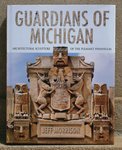

Look up. Look down. Look around you. That’s what the author-photographer and architectural historian Jeff Morrison wants readers to do after reading his new book, “Guardians of Michigan: Architectural Sculpture of the Pleasant Peninsula.”
Published by the University of Michigan Press, the book contains more than 1,200 photographs across 450 pages. It looks at the architectural embellishments of significant structures across the Great Lakes State.
Morrison said he was inspired to cover all of Michigan after the success of his first book, “Guardians of Detroit,” which concentrated on architectural art within the Motor City.
“I put on an awful lot of miles, traveling the State,” said Morrison, who uncovered gems statewide. “Almost every time I visited a city, I came across art I didn’t know about.”
While visiting Lansing, Morrison said he stopped at Sexton High School to photograph the sculptures by Corrado Parducci he knew about. Parducci, a prolific architectural artist, completed numerous architectural sculptures in Lansing.
“As I turned a corner at the school, there was more and more and more art,” he said.All photographs in the book were taken of buildings’ exteriors, despite the treasure troves inside each location. Sexton High School is one of the 95 featured buildings from 45 cities selected for a more in-depth look. They span from Ontonagon to Monroe. Each has a distinct ambiance.
“The art defines the building,” said Morrison, who hosts a free video presentation Thursday (Nov. 3) at the Library of Michigan, 702 E. Kalamazoo St., Lansing. He will have books available for sale.
“Guardians of Michigan” features more than 25 structures in Lansing and East Lansing. Perhaps the best-known building in Lansing, with the most significant architectural embellishments, is the City National Bank, now Comerica Bank. It receives several pages to showcase the work of Ulysses Ricci. A buffalo shares the front and sides of the building with sculptures depicting a dentist with a pair of pliers, a fleeing bank robber, an elephant and images from U.S. coins.
Just a short walk away are the sculptures by artist Corrado Parducci on the Michigan Bell Telephone Building on Capitol Avenue. Near that is the exterior sculpture executed by Leonard D. Jungwirth on Lansing City Hall. Jungwirth is best known for his Spartan on the MSU campus.
In addition to the featured buildings, an appendix contains 264 other buildings of note, including the Parducci sculpture on the Lansing Avenue Pumping Station off of Willow Street and the enchanting playful bears on Willow Elementary School by Jungwirth. One of the earliest examples of early architectural embellishment in the book is the magnificent “Rise and Progress of Michigan” by sculptor Carl Herman Wehner, which graces the pediment of the Michigan State Capitol.
Morrison also looks at the works of several sculptors on the campus of Michigan State University, including the exterior art on Jenison, the Einstein-Lawrence sculpture by Ralph Calder on the former Physics Astronomy Building and the Samuel Cashwan sculptures on the Music Building.
According to Morrison, most of the architectural art detailed in the new book can be traced to the latter part of the 20th century and the early decades of the 21st century.
“It was an era of a big building boom across the state,” he said. “The art represents the great pride in the community, and there is an effort to restore these buildings statewide.”
Morrison said he’s been a photographer since the age of 8 or 9, inspired by both his father and grandfather, both amateur photographers.
In addition to nature photography and shooting rock concerts while in college, Morrison said his first shot at architectural photography was of The Detroit News’ building on Cass Street in Detroit.
“I put them away and didn’t look at them for 10 or 15 years,” he said. “During a period when I was unemployed, I pulled them out and thought I’d do a tourist book to sell at gift shops.”
That idea blossomed into 2019’s “Guardians of Detroit.” Like a new parent, Morrison is hesitant to name a favorite building. “I tell people my favorite building is the next one,” he said.
However, he did discover a trove of architectural art at the William E. Scripps mansion in Lake Orion, which is very close to his home in Oxford. The estate has enough gargoyles and stone faces to scare off a legion of trick-or-treaters. That was new terrain for Morrison.
“I had never been there before,” he said.
The author hopes others will use the book to explore art in their hometowns. Certainly, Lansing-area residents will have the ability to use the book as a tour guide.
Morrison said he shot most of the photographs using a telephoto lens (a Tamron 150-600 mm on a Canon body). “It’s the only way you can shoot most of the art,” he explained.
But it wasn’t all just technical camera techniques. He also recalls climbing through a second-floor window of a rectory in Detroit to get on a roof and then climbing a steel ladder to get some shots of some hidden art at the adjacent church. All for the sake of documenting local history.
Support City Pulse - Donate Today!
Comments
No comments on this item Please log in to comment by clicking here